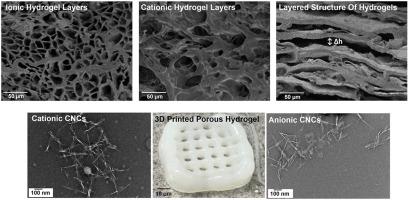Microporous and Mesoporous Materials ( IF 4.8 ) Pub Date : 2021-09-04 , DOI: 10.1016/j.micromeso.2021.111382 Jamileh Shojaeiarani 1 , Alimohammad Shirzadifar 2 , Dilpreet S. Bajwa 3

|
A porous multi-layered nanocomposite hydrogel, made of poly (ethylene oxide) (PEO) and cellulose nanocrystals (CNCs), suitable for the selective adsorption of different organic dyes has been developed via 3D printing. To obtain cationic and anionic CNCs and to facilitate the adsorption of positive and negative dyes, CNCs were modified. The cross-linked nanocomposite bioink was 3D printed to form a porous multilayered hydrogel with oppositely charged layers. SEM images revealed that surface charge has a predominant effect on the porous structure of hydrogel layers. The cationic hydrogel layer exhibited a large degree of randomness in pore size and geometry, however, ionic layers displayed well-organized pore structure. The cationic and anionic layer presented pore size in the range of 10–40 μm, and 10–30 μm, respectively. Surprisingly, the observed distance between adjacent layers and delamination phenomenon suggested missing adherence between layers due to long printing time, cooling temperature, and different chemical structures in adjacent layers. 3D printed hydrogels exhibited high equilibrium swelling ratios at different levels of pH (i.e., 4, 5, 8, and 9), while fastest swelling was observed at pH 8 and pH 9.An approximate 75% of maximum adsorption ratios was observed within the first 3 h of exposure. The hydrogel exhibited almost twice the adsorption capacity for MB in comparison with MG in the pH levels studied in this work. The maximum adsorption capacity for MB and MG was observed at pH 9 for 95.23 and 82.39%, respectively. The kinetics of adsorption was analyzed via pseudo-first and second orders, and Langmuir models. The adsorption kinetics followed the pseudo-second-order model well while equilibrium adsorption from the pseudo-first order and Langmuir exhibited a large difference with experimental data. The work provides promising results for the development of CNC-PEO materials as a multilayered adsorbent for effective and efficient dye decontamination of the wastewater.
中文翻译:

坚固且多孔的 3D 打印多功能水凝胶可有效去除水溶液中的阳离子和阴离子染料
通过 3D 打印开发了一种多孔多层纳米复合水凝胶,由聚环氧乙烷 (PEO) 和纤维素纳米晶体 (CNC) 制成,适用于不同有机染料的选择性吸附。为了获得阳离子和阴离子 CNCs 并促进正负染料的吸附,对 CNCs 进行了修饰。交联的纳米复合生物墨水被 3D 打印以形成具有相反电荷层的多孔多层水凝胶。SEM 图像显示表面电荷对水凝胶层的多孔结构有主要影响。阳离子水凝胶层在孔径和几何形状上表现出很大程度的随机性,然而,离子层显示出组织良好的孔结构。阳离子层和阴离子层的孔径分别在 10-40 μm 和 10-30 μm 范围内。出奇,观察到的相邻层之间的距离和分层现象表明由于印刷时间长、冷却温度和相邻层中不同的化学结构,层之间缺少粘附。3D 打印的水凝胶在不同的 pH 水平(即 4、5、8 和 9)下表现出高平衡溶胀率,而在 pH 8 和 pH 9 下观察到的溶胀最快。暴露的前 3 小时。在这项工作中研究的 pH 水平下,水凝胶对 MB 的吸附能力几乎是 MG 的两倍。在 pH 9 下观察到 MB 和 MG 的最大吸附容量分别为 95.23% 和 82.39%。通过拟一级和二级以及朗缪尔模型分析吸附动力学。吸附动力学很好地遵循拟二级模型,而来自拟一级和朗缪尔的平衡吸附与实验数据表现出很大差异。这项工作为开发 CNC-PEO 材料作为一种多层吸附剂对废水进行有效和高效的染料净化提供了有希望的结果。











































 京公网安备 11010802027423号
京公网安备 11010802027423号